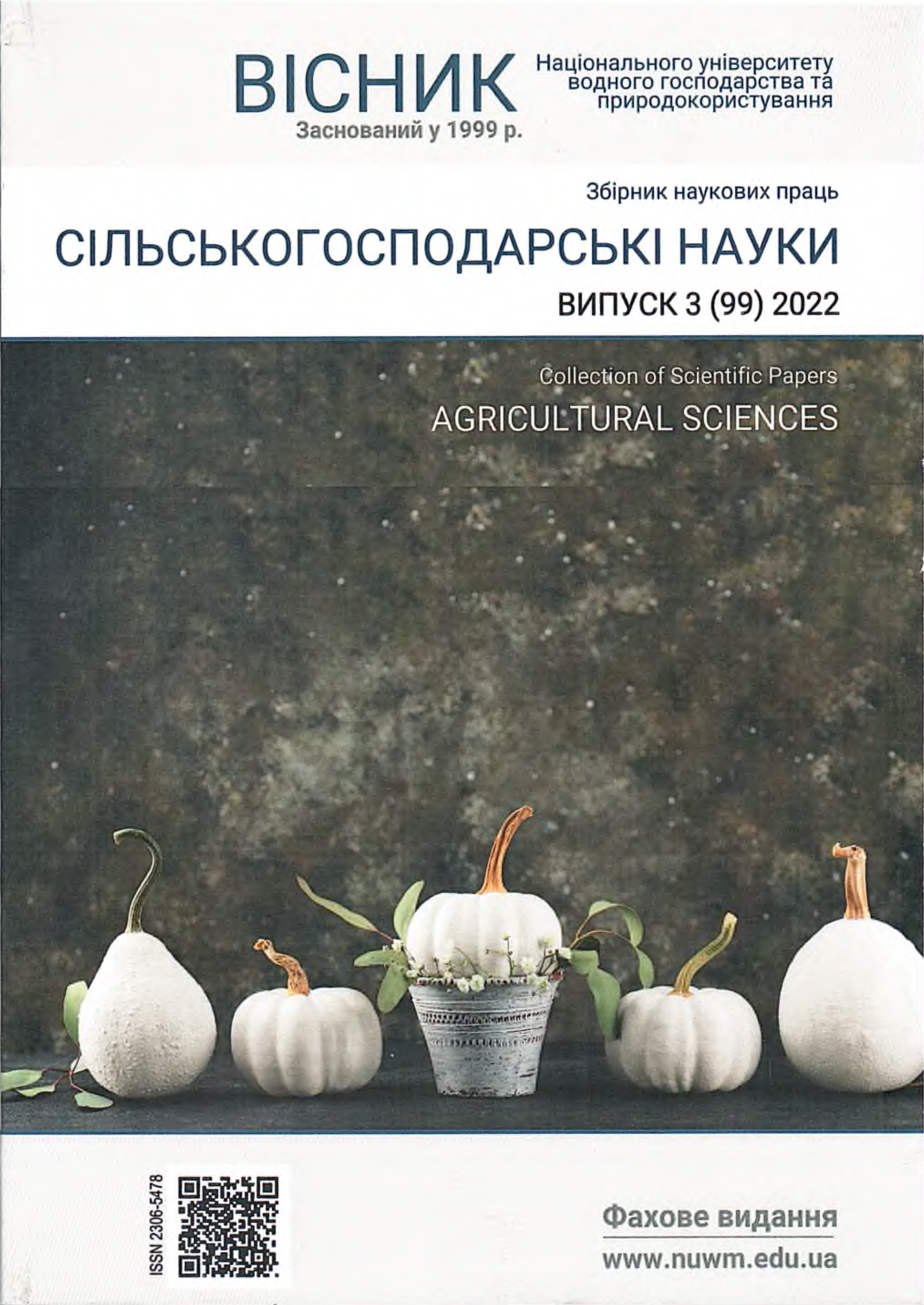CLASSIFICATION OF SOILS BROKEN BY ILLEGAL AMBER MINING
DOI:
https://doi.org/10.31713/320224Keywords:
degradation, classification, quantitative and qualitative assessment, crisis monitoring, reclamation.Abstract
The analysis of investigation of the level of harm to soil cover of forest, agrarian, water-swampy ecosystems was given that could be changed within the limits from 5 to 80% at a rate of one hectar in area and from 0,7 to 20 m in depth having caused the annihilation of fertile layer of soil, the destruction of maternal and in some cases bedding types of soils, violation of hydrological regulations of the territories, the emersion of erosion process.Because of these reasons anthropogene cycle of evolution of forest, agrarian, water-swampy ecosystems soil cover, which was accompanied by slow reducing of their fertility in ordinary conditions, was changed by sudden (befurcational branch of evolution of soil genesis) degradation of their fertility indices.To estimate these sharp changes there was worked out classification based on binary system aimed at estimation of soil state, not broken by amber mining areas where the systematization is used based on their nomenclature, rating and diagnostics suggested by M.M. Sibirtsev. And on the broken areas there is supplement to this classification of ecological, genetic characteristics which reflects the direction of degradation process of these soils and the degree of their display from weakly degradated to strongly degradated, having possibility to define the state of broken or unbroken soils according to integrated average index on the areas, both quantitavely and qualitatively.It is ascertained that common indication in suggested classification for soils of forest, agrarian, water-swampy ecosystems broken byillegal amber mining is formation of quantative and qualitative estimation of their degradation degree both of the areas and of the depth.The worked out classification was based on the formation of monitory system that envisages the realization of control, estimation and prediction of changes in the state of unbroken and broken soils by illegal amber mining. According to certain physical, chemical, agrochemical, water and also integrated average indices it is possible to define their degree of degradation quantitavely and qualitatively after the scale: 1,0–0,68 – weakly degradated, 0,68–0,48 – partly degradated, 0,48–0,19 – quite degradated, 0,19–0 – strongly degradated. On the grounds of this estimation administrative solution concerning technologies of these soils recultivation can be substantiated.References
Ковалевський С. Б., Ковалевський С. С., Долід О. М. Стан лісових ділянок ДП «Сарненський ЛГ», порушених внаслідок незаконного видобутку бурштину. Науковий вісник НЛТУ України. 2019. № 7. Т. 29. С. 96–100.
Ґрунтознавство : підручник / Д. Г. Тихоненко, М. О. Горін, М. І. Лактіонов та ін. ; за ред. Д. Г. Тихоненка. К. : Вища освіта, 2005. 703 с.
Клименко М. О., Борисюк Б. В., Колесник Т. М. Збалансоване використання земельних ресурсів : навч. посіб. Херсон : ОЛДІ-ПЛЮС, 2014. 552 с.
Моторина Л. В., Овчинников В. А. Промышленность и рекультивация земель. М. : Мысль, 1975. 240 с.
Ґрунти України: властивості, генезис, менеджмент родючості : навч.
посіб. / за ред. В. І. Купчик, В. В. Іваніна, Г. І. Нестеров та ін. К. : Кондор. 2007. 414 с.
Клименко М. О., Ковальчук С. В. Аналіз впливу осушувальних
меліорацій на водно-болотні угіддя Волинського Полісся (на прикладі Шацького Національного природного парку). Вісник НУВГП. Сільськогосподарські науки. 2006. Вип. 3(35) С. 18–24.
Клименко М. О., Володимерець В. О.,
Ковальчук С. В. Флористична та фітоценотична різноманітність водноболотних угідь ШНПП як основа для здійснення моніторингу його стану. Наукові доповіді НУБіП України. 2021. № 3(21). С. 1–14.
Ковальчук С. В. Класифікація та моніторинг водно-болотних угідь за абіотичними і біотичними ідентифікуючими ознаками (на прикладі Шацького національного природного парку) : автореф. дис. … канд. с.-г. наук. Рівне, 2021. 23 с.
Сибирцев Н. М. Почвоведение : собр. соч. М., 1951. Т. 1. 472 с.
Гринченко А. М. Теория и практика окультуривания почв и воспроизводство их эффективного экономического плодородия. Харьков, 1973. Т. 195. С. 3–13.
REFERENCES:
Kovalevskyi S. B., Kovalevskyi S. S., Dolid O. M. Stan lisovykh dilianok DP «Sarnenskyi LH», porushenykh vnaslidok nezakonnoho vydobutku burshtynu. Naukovyi visnyk NLTU Ukrainy. 2019. № 7. T. 29. S. 96–100. 2. Gruntoznavstvo : pidruchnyk / D. H. Tykhonenko, M. O. Horin, M. I. Laktionov ta in. ; za red. D. H. Tykhonenka. K. : Vyshcha osvita, 2005. 703 s.
Klymenko M. O., Borysiuk B. V., Kolesnyk T. M. Zbalansovane vykorystannia zemelnykh resursiv : navch. posib. Kherson : OLDI-PLIuS, 2014. 552 s.
Motorina L. V., Ovchinnikov V. A. Promyishlennost i rekultivatsiya zemel. M. : Myisl, 1975. 240 s.
Grunty Ukrainy: vlastyvosti, henezys, menedzhment rodiuchosti :
navch. posib. / za red. V. I. Kupchyk, V. V. Ivanina, H. I. Nesterov ta in. K. : Kondor. 2007. 414 s.
Klymenko M. O., Kovalchuk S. V. Analiz vplyvu
osushuvalnykh melioratsii na vodno-bolotni uhiddia Volynskoho Polissia (na prykladi Shatskoho Natsionalnoho pryrodnoho parku). Visnyk NUVHP.
Silskohospodarski nauky. 2006. Vyp. 3(35) S. 18–24.
Klymenko M. O.,
Volodymerets V. O., Kovalchuk S. V. Florystychna ta fitotsenotychna
riznomanitnist vodno-bolotnykh uhid ShNPP yak osnova dlia zdiisnennia monitorynhu yoho stanu. Naukovi dopovidi NUBiP Ukrainy. 2021. № 3(21). S. 1–14.
Kovalchuk S. V. Klasyfikatsiia ta monitorynh vodno-bolotnykh uhid za
abiotychnymy i biotychnymy identyfikuiuchymy oznakamy (na prykladi
Shatskoho natsionalnoho pryrodnoho parku) : avtoref. dys. … kand. s.-h. nauk. Rivne, 2021. 23 s.
Sibirtsev N. M. Pochvovedenie : sobr. soch. M., 1951. T. 1.
s.
Grinchenko A. M. Teoriya i praktika okulturivaniya pochv i
vosproizvodstvo ih effektivnogo ekonomicheskogo plodorodiya. Harkov, 1973. T. 195. S. 3–13.

